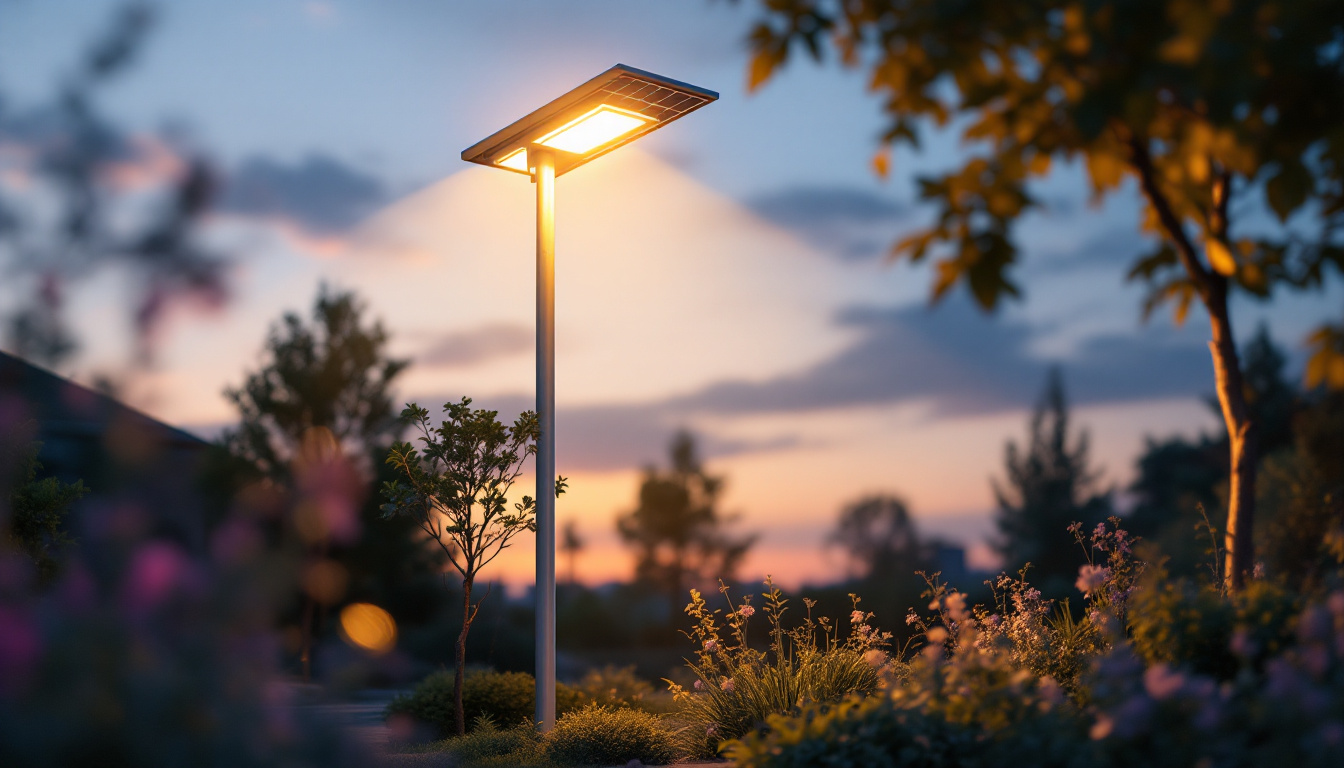

As the demand for sustainable energy solutions continues to rise, the integration of solar technology into urban infrastructure has become increasingly prevalent. Light pole solar systems are at the forefront of this transformation, providing an energy-efficient and environmentally friendly alternative to traditional lighting methods. For lighting contractors, understanding the intricacies of light pole solar is essential for staying competitive in the evolving market. This article will explore the fundamentals of light pole solar systems, their benefits, installation considerations, and future trends.
Light pole solar systems consist of solar panels mounted on light poles, which harness sunlight to generate electricity for illuminating public spaces, roadways, and parking lots. These systems typically include solar panels, LED lighting fixtures, batteries for energy storage, and a charge controller to manage the flow of electricity. As urban areas continue to grow, the need for sustainable and efficient lighting solutions becomes increasingly important, making light pole solar systems an attractive option for municipalities and businesses alike.
The key components of a light pole solar system work together to ensure efficient operation. Solar panels convert sunlight into electricity, while LED fixtures provide illumination with minimal energy consumption. Batteries store excess energy generated during the day, allowing the lights to operate during the night. The charge controller regulates the charging and discharging of the batteries, ensuring longevity and optimal performance. Additionally, many systems are equipped with smart technology that can adjust brightness levels based on ambient light conditions or detect motion, further enhancing energy efficiency and safety.
Understanding these components is crucial for contractors, as it allows them to assess the specific needs of a project, select appropriate materials, and troubleshoot potential issues during installation and maintenance. Furthermore, familiarity with local regulations and incentives for solar installations can provide contractors with valuable insights that may influence project design and budgeting, ultimately leading to more successful outcomes for their clients.
There are various types of solar lighting solutions available, each designed to meet different requirements. Some common types include:
Each type has its advantages and disadvantages, and contractors should evaluate project requirements to determine the best fit. For instance, while standalone solar lights offer independence from the grid, they may require more frequent maintenance in areas with heavy snowfall or debris accumulation. On the other hand, grid-tied systems can provide a more stable power supply but may involve higher installation costs and ongoing utility fees. By carefully considering these factors, contractors can tailor their solar lighting solutions to meet the unique needs of each project, ensuring both functionality and sustainability.
Light pole solar systems offer numerous advantages for both contractors and end-users. Understanding these benefits can help contractors effectively communicate the value of solar lighting solutions to clients.
One of the most significant benefits of solar lighting is its positive impact on the environment. By using renewable energy, these systems reduce reliance on fossil fuels, decreasing greenhouse gas emissions. This shift not only contributes to a healthier planet but also aligns with the growing demand for sustainable practices in urban planning and development. Moreover, solar lighting systems can contribute to biodiversity by minimizing light pollution, allowing nocturnal wildlife to thrive in their natural habitats. As cities become more aware of their ecological footprints, integrating solar solutions into urban landscapes becomes an essential strategy for promoting ecological balance.
While the initial investment in solar lighting may be higher than traditional systems, the long-term savings can be substantial. Solar lights require minimal maintenance and have no ongoing electricity costs, leading to lower operational expenses over time. Additionally, many municipalities and organizations are increasingly offering incentives and rebates for the installation of solar lighting, further enhancing cost-effectiveness. The durability of solar lighting fixtures, often designed to withstand harsh weather conditions, means that replacements are infrequent, further reducing lifecycle costs. As technology advances, the efficiency of solar panels and batteries continues to improve, making these systems an even more attractive option for budget-conscious projects.
Well-lit public spaces contribute to enhanced safety and security. Solar lights can be installed in areas that may not have access to electrical infrastructure, improving visibility in parks, pathways, and parking lots. This increased illumination can deter criminal activity and create a more welcoming environment for residents and visitors alike. Additionally, the strategic placement of solar lights can enhance community engagement by encouraging outdoor activities during evening hours, fostering a sense of community and belonging. The ability to install these systems in remote or underserved areas also plays a crucial role in bridging the gap in safety and accessibility, ensuring that all community members can enjoy well-lit spaces regardless of their location.
When it comes to installing light pole solar systems, several factors must be taken into account to ensure successful implementation. Lighting contractors must be well-versed in these considerations to deliver optimal results.
A thorough site assessment is essential before installation. Factors such as sunlight exposure, shading from trees or buildings, and the geographical location will influence the performance of solar panels. Contractors should evaluate the site to determine the best positioning for solar panels and light fixtures to maximize energy generation.
Before commencing installation, contractors must familiarize themselves with local regulations and permitting requirements. Many municipalities have specific guidelines regarding the installation of solar lighting, including height restrictions, aesthetic considerations, and safety standards. Ensuring compliance with these regulations is crucial to avoid potential legal issues and project delays.
Proper system design is vital for achieving the desired lighting levels. Contractors must calculate the total wattage required for the area to be illuminated and size the solar panels and batteries accordingly. This process involves considering factors such as the average daily sunlight hours, the efficiency of the solar panels, and the energy consumption of the LED fixtures.
While light pole solar systems are designed for durability and low maintenance, regular inspections and maintenance are essential to ensure optimal performance. Contractors should be prepared to address common issues that may arise during the lifespan of the system.
Conducting routine inspections can help identify potential issues before they escalate. Contractors should check for debris accumulation on solar panels, ensuring they remain clean and unobstructed. Additionally, inspecting the LED fixtures for functionality and the batteries for signs of wear can help maintain system efficiency.
Common issues that may arise with light pole solar systems include:
The landscape of solar lighting technology is continually evolving, driven by advancements in technology and changing consumer preferences. Staying informed about future trends can help contractors remain competitive and adapt to market demands.
As smart city initiatives gain momentum, the integration of smart technology into light pole solar systems is becoming increasingly common. Features such as motion sensors, remote monitoring, and adaptive lighting can enhance energy efficiency and improve user experience. Contractors should consider incorporating smart technology into their designs to meet the needs of modern urban environments.
Advancements in energy storage technology are also shaping the future of light pole solar systems. Innovations in battery technology, such as lithium-ion and flow batteries, are leading to improved energy storage capacity and longer lifespans. These advancements can enhance the reliability of solar lighting systems, particularly in areas with inconsistent sunlight.
As the demand for aesthetically pleasing urban environments increases, manufacturers are developing solar lighting solutions that blend seamlessly with architectural designs. From sleek, modern fixtures to decorative poles, contractors can offer clients a range of options that enhance the visual appeal of public spaces while maintaining functionality.
Light pole solar systems represent a significant advancement in sustainable lighting solutions, offering numerous benefits for contractors and end-users alike. Understanding the components, benefits, installation considerations, and future trends of these systems is essential for lighting contractors looking to thrive in an increasingly competitive market.
By embracing solar technology, contractors can not only contribute to a more sustainable future but also provide clients with innovative solutions that enhance safety, reduce costs, and improve the overall quality of urban spaces. As the industry continues to evolve, staying informed and adaptable will be key to success in the realm of light pole solar systems.
Ready to elevate your lighting projects with the efficiency and sustainability of light pole solar systems? At LumenWholesale, we provide lighting contractors with the highest quality, spec-grade solar lighting products at unbeatable wholesale prices. Say goodbye to inflated markups and hello to premium lighting solutions that meet the highest industry standards. With our hassle-free bulk buying and free shipping, you can ensure your projects shine brightly while enjoying the best value. Don’t compromise on quality or cost. Discover wholesale lighting at the best value today and light up your next project with confidence.

Discover the essentials of solar-powered LED lighting for contractors.

Discover the must-have essentials for lighting contractors working with industrial lamp kitchens.

Illuminate your outdoor space efficiently with our comprehensive guide on driveway lights solar.

Discover essential insights into strip lights with our comprehensive guide tailored for lighting contractors.
Get notified when NEW deals are released.
Optimize your budget with wholesale discounts.
Only top-quality, specification-grade lighting products.
No additional costs at checkout - what you see is what you pay.
We understand the unique needs of contractors.